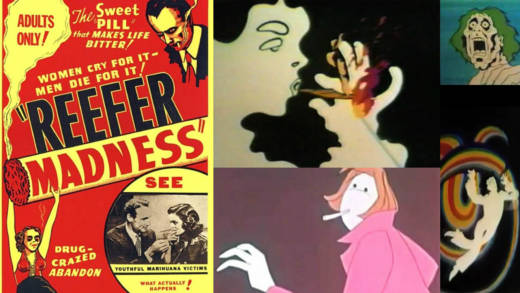The 1950s approach to discouraging people from using weed mostly involved committing full tilt to the idea that smoking marijuana would almost certainly lead to a life of heroin addiction. 1958's High School Confidential featured a stark warning: "If you flake around with the weed, you'll end up using the harder stuff."
A PSA from the same decade titled Drug Addiction followed a similar track, firmly setting up marijuana as a gateway drug. Watch between 6:52 and 8:25 to enjoy one of the most clean-cut heroin addicts in history explaining to a judge that he smoked marijuana for “4 or 5 months” before immediately jumping headfirst into junkie-dom.
By the 1960s, probably sensing that they were losing the youth battle, PSAs made vague attempts to be moderately more balanced. In Keep Off the Grass, we see a young man named Tom having a variety of sensible discussions with grown ups and questioning his peers. He starts out his PSA journey saying things to his Dad like: “It’s easy for you to stand there with a cigarette in one hand and a drink in the other and tell us not to blow pot!”
This being a PSA though, Tom's journey takes a turn pretty quickly, and ultimately, the overarching message becomes clear: "Every time you blow a marijuana cigarette, you take a chance on blowing your future.” In the end, arguably the greatest thing about the 20-minute clip is the coining of the term "Psychedelicatessen,” in reference to a head shop.
Other notable 1960s PSAs include Drug Abuse: The Chemical Tomb, in which THC is discussed, and a firm reminder is given: "Marijuana is a drug, just like LSD is a drug, or methamphetamine is a drug." Another PSA from the period unintentionally makes drugs look super fun, with possibly the greatest voiceover script in cautionary tale history: "This is the real action! The pot party, the trippers, the grasshoppers!”
By the end of the 1960s, PSAs took an ironically trippy turn, after animation became employed in the fight to persuade kids that marijuana was dangerous. The following psychedelic cartoon was undoubtedly made even crazier by commentary that referred to weed as: "The hula hoop of the jet generation."
In the '70s, PSA creators didn't just stick with the cartoon idea, they ran all the way to the top of the animation pile and hired Flintstones / Scooby Doo / Jetsons creators, Hanna-Barbera to sell the idea that drugs were bad. The results were utterly mind-bending, thanks to a stoned guy riding on a rainbow, pills that literally hold your hand, some kind of evil wardrobe of death, and a joint with arms and legs, wearing what appears to be a Santa hat.
Undeterred by the weirdness of that last one, the animation theme continued unabated with Drug Disaster, a cartoon (apparently produced by the Lockheed Aircraft Corporation!) featuring a Professor Caveman (surely a contradiction in terms?), a stoned guy literally climbing a wall, and victims of weed-induced hallucinations who can no longer see their own faces when they look in the mirror.
Of course, cartoons can never pull off the level of overwrought hand-wringing that live action clips can. This next one makes a few odd creative choices, starting with a voiceover that makes the utterly implausible claim that: "I had six people that I counted as friends who used marijuana. They never did graduate to heroin. You know why? Because on marijuana, they committed crimes of passion and were electrocuted before they got a chance to get hooked on horse.”
This lady is literally asking us to believe that she has six friends who've all been executed because of weed-induced criminality. What's even stranger, this PSA meanders off the point to such a degree that it ends up being a sort of how-to guide—especially when it comes to some of the information given to the school children in the film. (Did YOU know that bobby pins could be used as roach-clips?)
After that kind of chaos, a major propaganda re-think was needed. In the '80s, young-teens were targeted by anti-weed organizers in a nonsensical way that suggested that being allowed to go to the mall on your own and choosing your own clothes were the first steps towards discovering drugs. Another PSA asked teens to look at cannabis-smoking as a dangerous experiment they wouldn't partake in if it took place in a lab. The real stroke of genius though, came when someone realized that the best way to reach kids was through their favorite television characters.
Which is how David Hasselhoff and his talking car got involved:
The TV show angle must have been deemed successful because it continued into the '90s, with a PSA from the Teenage Mutant Ninja Turtles in which they advised kids that, instead of smoking pot, they should "Get a teacher," "Get a pizza," or "Get real." The Turtles also starred in Cartoon Stars to the Rescue, a 30-minute-long suggestion to steer clear of marijuana and alcohol, alongside other TV luminaries including Alf, Alvin and the Chipmunks, Bugs Bunny, the Muppet Babies, Winnie the Pooh, Garfield, and the Smurfs.
Check out this version that comes with a heart-warming introduction from George and Barbara Bush. "Some of your favorite cartoon characters," George nods, "will help you understand how drugs and alcohol can ruin your life."


